The Toyota Innova’s iconic status can’t be overstated. It has been the preferred choice amongst millions of customers both from the institutional and the individual buyer segments in the MPV market. The Innova’s endearing qualities over the generations have been its ride comfort, its legendary reliability and the build quality that has set it apart from the competition. Now, even as rumours abound about the possibility of an all-electric Innova coming next year, and even as there are lingering worries that the current diesel Innova Crysta maybe pulled out, Toyota has gone ahead and launched a brand new Innova Hycross featuring its hybrid technology.
The Innova Hycross is an all-new generation for Innova and nothing from the Innova Crysta has been carried forward. It has been built ground up based on the TNGA-C High (Toyota New Global Architecture) platform and now features a monocoque, compared to the Crysta’s ladder frame chassis. The 3-row premium MPV is also marginally bigger than the current model with the wheelbase increasing by 100mm, though the overall length and width are up only by 20mm each. The monocoque construction has helped lower the weight of the new Innova Hycross by 200 kg compared to the Crysta, and the non-hybrid version is almost 350kg lighter in the absence of the battery pack and e-motor.
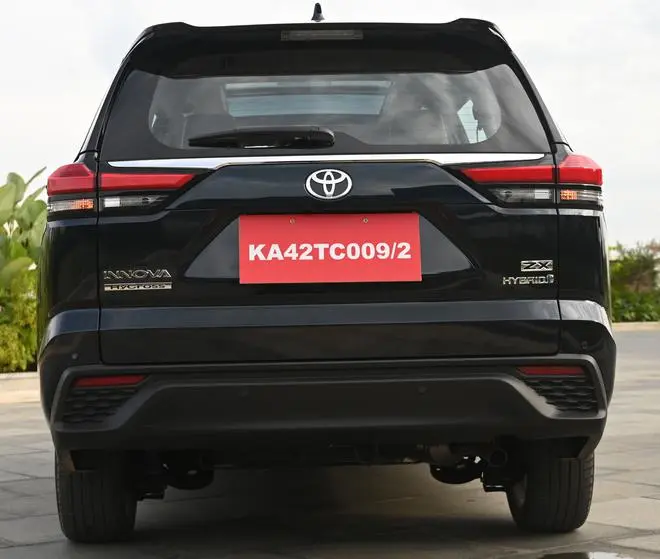
The 3-row premium MPV is also marginally bigger than the current model with the wheelbase increasing by 100mm, though the overall length and width are up only by 20mm each
The monocoque has also allowed a dedicated, protected storage spot under the front seats for the 168-cell NiMH (nickel metal hydride) battery pack of the hybrid system. The Hycross is now a front-wheel driven vehicle compared to the rear-wheel driven Crysta. And even in the petrol-only Hycross with its CVT transmission, doesn’t feature a central transmission tunnel and so the second row and third row get a clean, flat floor.

For fans of the Innova Crysta and its Diesel engine, let me clarify that the current model will continue to be available in parallel to the new Innova Hycross. So, you would have a choice between the Innova Crysta for the Diesel engine and the Innova Hycross with its brand-new petrol engine, and also the same engine paired with hybrid tech. Toyota hasn’t been taking orders for the diesel during the last few months due to a short supply of the Diesel engine kits. But it will be opened again for bookings within the next few weeks, say Toyota officials.
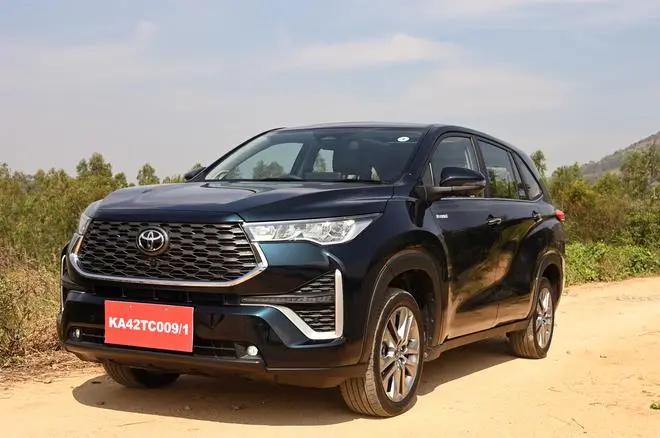
The Hycross is the new generation Innova in other markets too. But the Indian market is one of the largest contributors for the brand’s global volumes and it is good to note that a lot of inputs for its design and build were given by the Indian subsidiary. For the Hycross, Toyota has attempted to infuse a bit of SUV flavour into the design. And instead of the more conservative design language that the Japanese brand usually adopts, the Hycross’s design is, I’d say even a bit adventurous. It is still largely MPV in profile, and there are still references to the current Innova, but the front design is very fresh and sporty. The test mule that I was driving earlier this week in Bengaluru was the top-spec hybrid variant and this featured slim LED headlamps, sitting on either side of a new hexagonal-style grille.
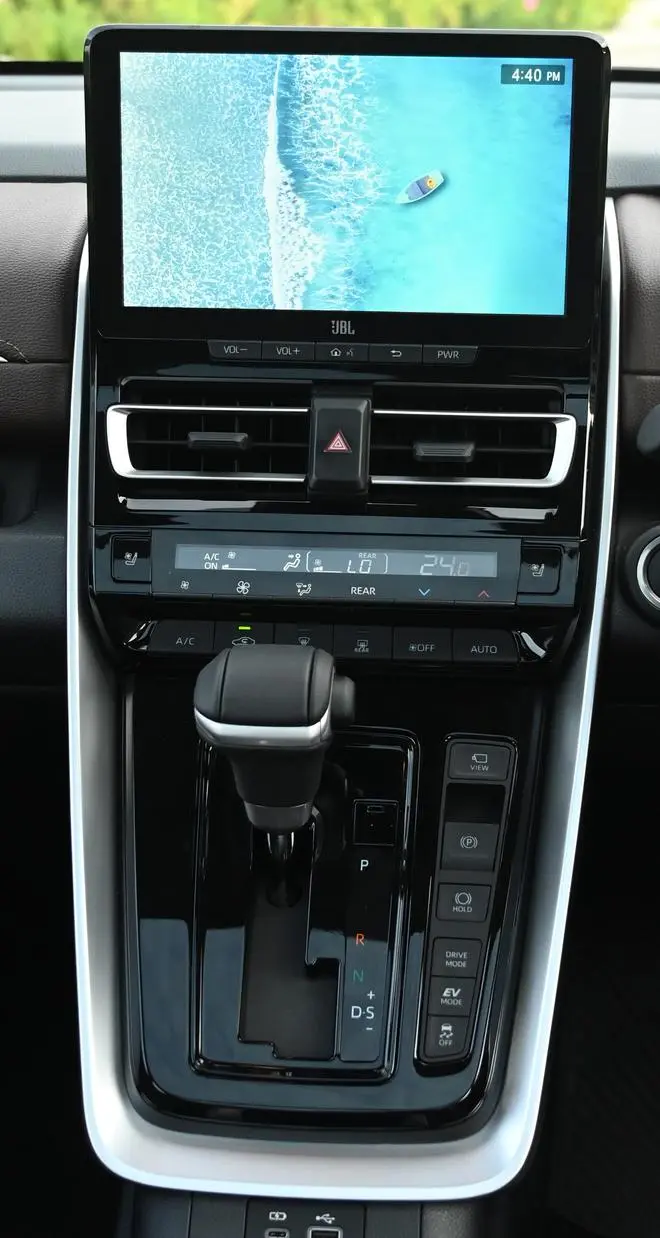
The 25.6cm infotainment touchscreen on the centrestack offers the usual suite of controls, has wireless Apple CarPlay connectivity and also display info like the hybrid’s energy flow
The Crysta had a slatted bonnet grille, instead, the Hycross gets a honeycomb grille with a chrome frame for the lower half. The slim airdam in the front fender sports LED DRLs that double up as turn indicators. The high-set, SUV-like bonnet is a wide unit that sports a V-shaped power dome crease. The A-pillar is steeply raked in the Innova Hycross and creates a roofline that is similar to the Crysta, though the roof mildly tapers down towards the rear. The longer wheelbase is evident when the new vehicle is viewed from the side. While that should translate into more space in the cabin, the Innova Hycross’s rear doors have also become wider and should allow for easier access into the second and third row seats. The prominent flared arches for the rear wheels gives the Hycross more similarities with the Crysta. The rear design, though, is very different. With a pair of wraparound tail-lamps that sit on the haunches and accentuate the width of the Hycross and a full-size powered tailgate, the Hycross hybrid top-spec’s design delivers a premium image.
Cabin
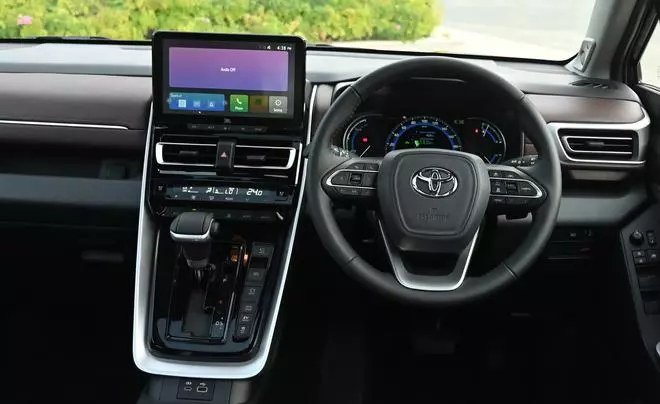
The dashboard layout is still vertical, with the centre stack and its elements delivering an even more premium feel compared to the Crysta
The interior of the Innova has witnessed quite a lot of upgrades over the past two generations. In the segment in which the Innova sits, it sports a clean and a premium cabin, but the competition has moved on and vehicles like the Kia Carens have been nipping at the heels of the Innova Crysta with their features list. So, the new Innova Hycross’s focus has been set squarely on improving quality and quantity of cabin kit. There is a lot that’s been done just for the seats, with quilted artificial leather upholstery for the first and second-row captain seats, power adjustments for the driver and seat ventilation for the front two seats. In the top-spec hybrid 7-seater Hycross that I was driving, there is more focus on the rear passengers too. The second-row captain seats get powered backrests and a leg rest that can be electrically raised to create a business-class style reclined seat (Toyota calls it ottoman seats). Other features include a panoramic sunroof, ambient lighting, wireless phone charger, multi-zone aircon and a 9-speaker JBL music system. The dashboard layout is still vertical, with the centre stack and its elements delivering an even more premium feel compared to the Crysta. The short gear stick for the e-CVT transmission is positioned ergonomically within easy reach for the driver and is a huge jump in refinement compared to ‘vibey’ manual gearsticks of previous-gen Innovas. No manual transmissions in the new Hycross.
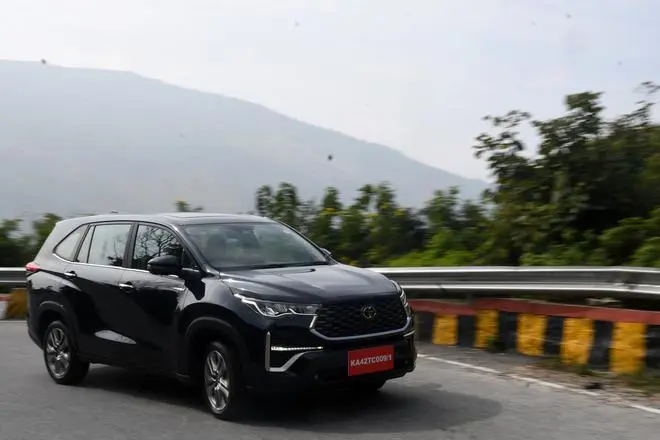
For the Hycross, Toyota has attempted to infuse a bit of SUV flavour into the design
The choice of materials and trim elements for the dashboard and door panels elevate the cabin in the new Innova Hycross. Some references to the Crysta are there including the aircon vents, but the seat position and view of the road is more SUV-like, in fact it is a bit like the Fortuner’s view for the driver. The space available for all the occupants in the Innova Hycross is good, even third-row occupants gets better legroom compared some of the other 3-row MPVs. Some of the features will be trim variant dependent, but there are also connected car features like remote vehicle ignition, stolen vehicle tracking, smartwatch connectivity and even remote windows. The hybrid Hycross that I was driving also featured two digital screens for displaying real-time info and for controlling infotainment functions. The 17.8cm instrument panel has a clear readout and changes colour and display style depending on driving mode chosen. The 25.6cm infotainment touchscreen on the centrestack offers the usual suite of controls, has wireless Apple CarPlay connectivity and also display info like the hybrid’s energy flow.
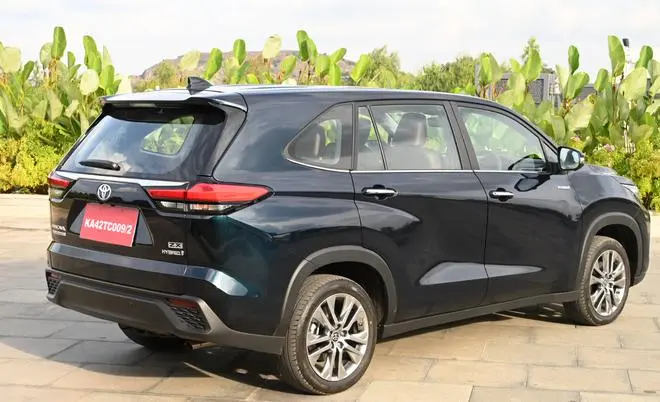
The prominent flared arches for the rear wheels gives the Hycross more similarities with the Crysta
Performance
The new Innova Hycross features Toyota’s fifth-gen self-charging hybrid tech. Not very unlike the tech used in the Urbancruiser Hyryder, this one too features a battery pack, an electric motor with related electronics, and a 2-litre Atkinson cycle petrol engine. The petrol-only and the petrol hybrid models of the Innova Hycross both feature the same 1,987cc petrol engine. This is a 4-cylinder unit that also features intelligent variable valve timing and is inherently more fuel efficient thanks to the Atkinson cycle injection. The output though varies between the petrol-only and the hybrid models. I was offered only the hybrid variant in which engine and motor combine to generate a peak power of 183.7hp. Torque fed to the front wheels by the engine is 188Nm and that generated by the motor is 206Nm. The entire petrol battery hybrid system is constantly monitored and controlled by an electronic control unit. The transmission is an e-Drive sequential shift gearbox that is said to intelligently prioritise efficiency and performance to enable a pure electric range and both series and parallel electric motor assist for the petrol engine. Toyota officials say that the pure EV mode range can’t be accurately calculated since it is dependent on multiple factors including state of charge for the self-charging battery pack.
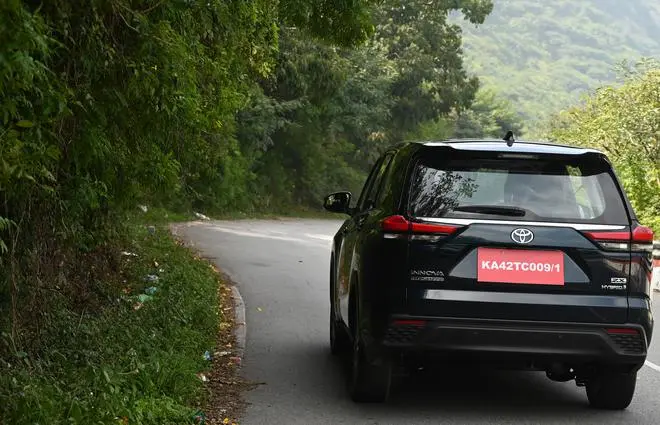
The 1.6kwH battery pack is nearly twice as big as the one in the UrbanCruiser Hyryder. But the Innova Hycross is also a bigger and heavier vehicle. There are three drive modes to choose from — Eco, Normal and Power. There is not much of a difference in acceleration from standstill between Normal and Power. But, in Power mode the Hycross did feel more eager to shift down, and even stayed in chosen gear for longer while being driven in manual mode (six preset slots). Gear shifts are imperceptible and powertrain refinement is excellent. Toyota claims a run to 100kmph is less than ten seconds for the hybrid; yet in terms of sheer pulling power and low-end torque feel, the diesel still can’t be beaten. However, the new Hycross won’t leave buyers feeling disappointed when it comes to fuel efficiency; rated mileage is 21.1kmpl and a real-world mileage of 14-15kmpl should be possible with the hybrid. The petrol-only powertrain feels even less peppy, without the assistance of the electric motor. Here the engine is paired with a direct shift CVT and the output from this combination is 171.6hp and a peak torque of 205Nm. With this powertrain too, buyers can manually select from ten preset sequential gears using steering-mounted paddles.
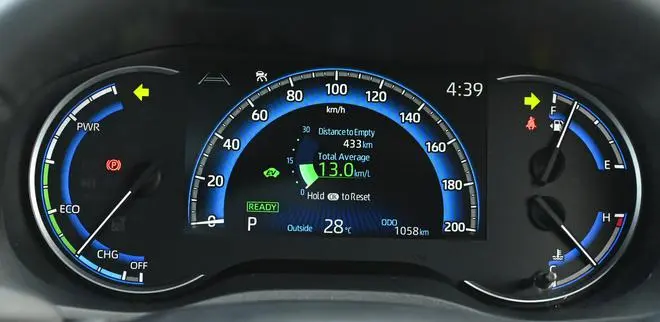
One of the first impressions about the Innova Hycross’s ride quality is a feeling of lightness. This is not just a result of the monocoque and its lower weight and higher stifffness. This is probably also hightened by the much lighter and sensitive electric power steering that has replaced the Crysta’s hydraulic unit. Making u-turns is easier and slow-speed manoeuvrability is much improved. The ride quality which has been a trademark for the Innova is also enhanced and is still bordering on being wallowy without leading to too much body roll or vertical movement at the passenger seat level. Toyota engineers tell me that the suspension was benchmarked to the Crysta, but the setup was selected for the monocoque construction.
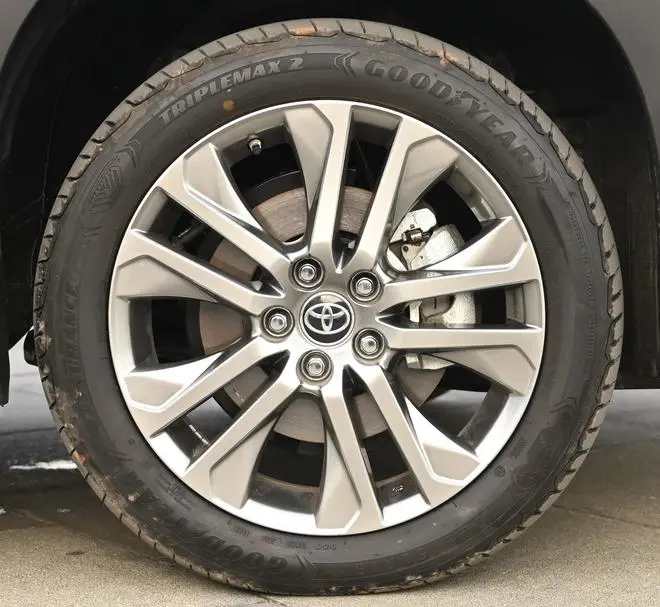
Bottom Line
Depending on the variant, the new Innova Hycross offers a range of safety features including six airbags. There is also the optional addition of Toyota Safety Sense, the term the company uses for a range of driver assistance system (ADAS) features, which include adaptive cruise control, lane keeping assistance, brake assist (thankfully not very intrusive), blind-spot monitoring and rear cross traffic alert. Some trim variants also get a 360° reversing camera.
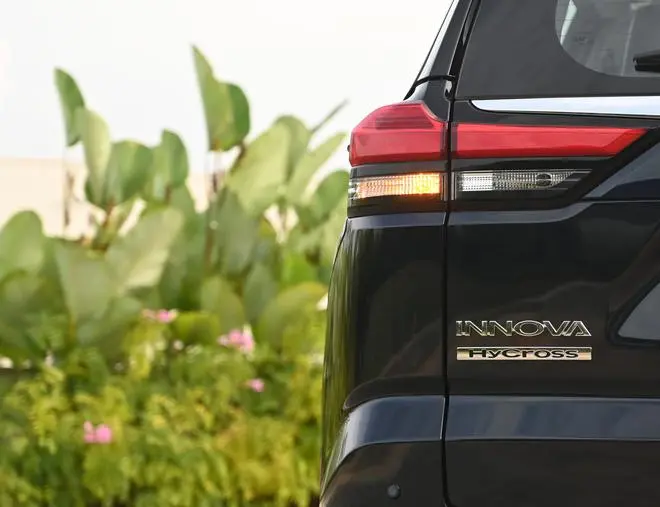
Toyota Hycross Hybrid. Photo : Bijoy Ghosh To go with Muralidhar's report | Photo Credit: BIJOY GHOSH
Overall, the new Innova Hycross is a ‘hy-jump’ over the current Crysta. There are a few plastic parts in the cabin which could’ve been better finished. But the overall impression that I came away with is that this is a worthy upgrade. I still missed the diesel’s low-end torque character. Yet, this is still the best premium petrol MPV that your money can get you. Expect prices to range from ₹20 lakh to ₹30 lakh.




Comments
Comments have to be in English, and in full sentences. They cannot be abusive or personal. Please abide by our community guidelines for posting your comments.
We have migrated to a new commenting platform. If you are already a registered user of TheHindu Businessline and logged in, you may continue to engage with our articles. If you do not have an account please register and login to post comments. Users can access their older comments by logging into their accounts on Vuukle.